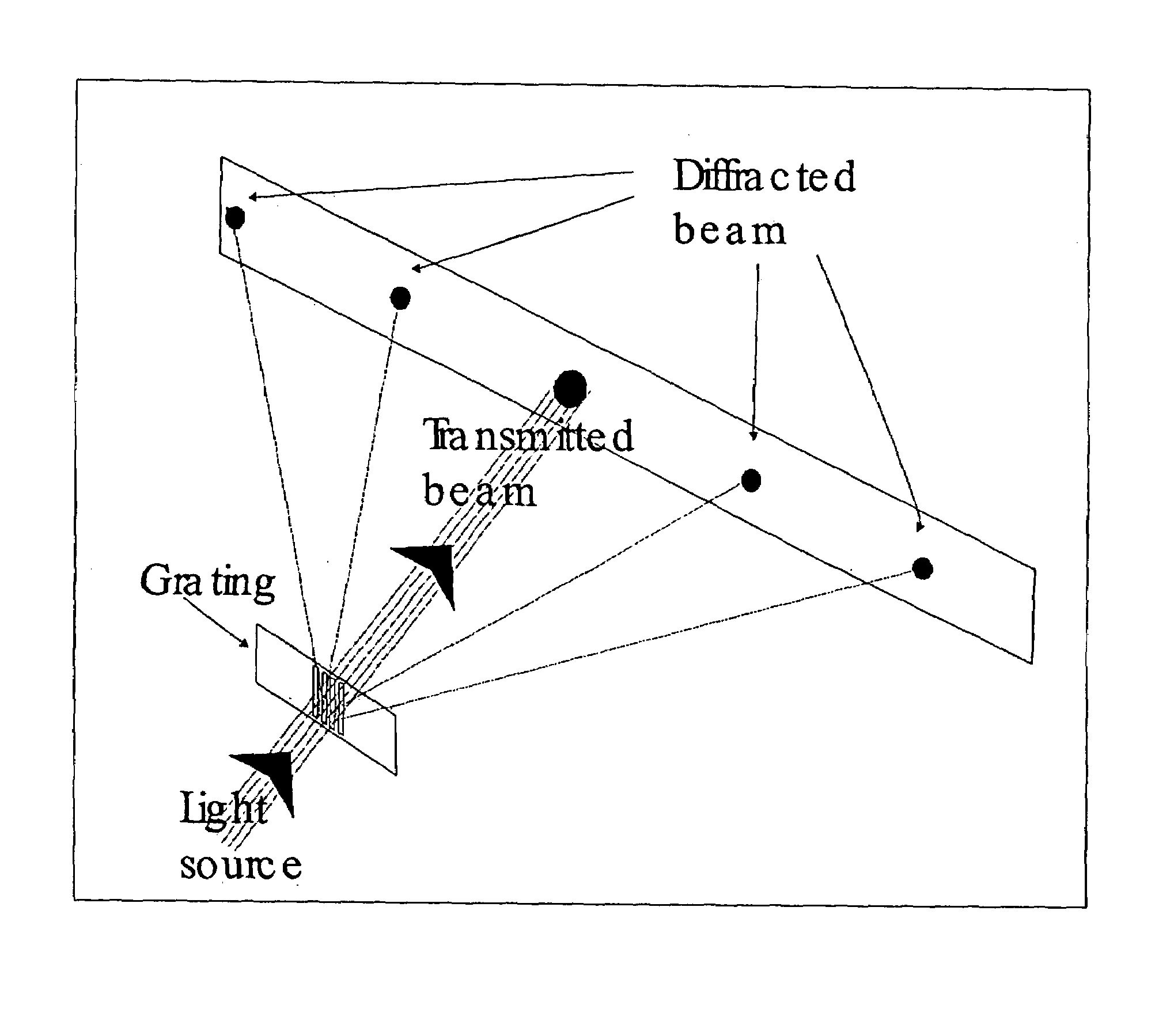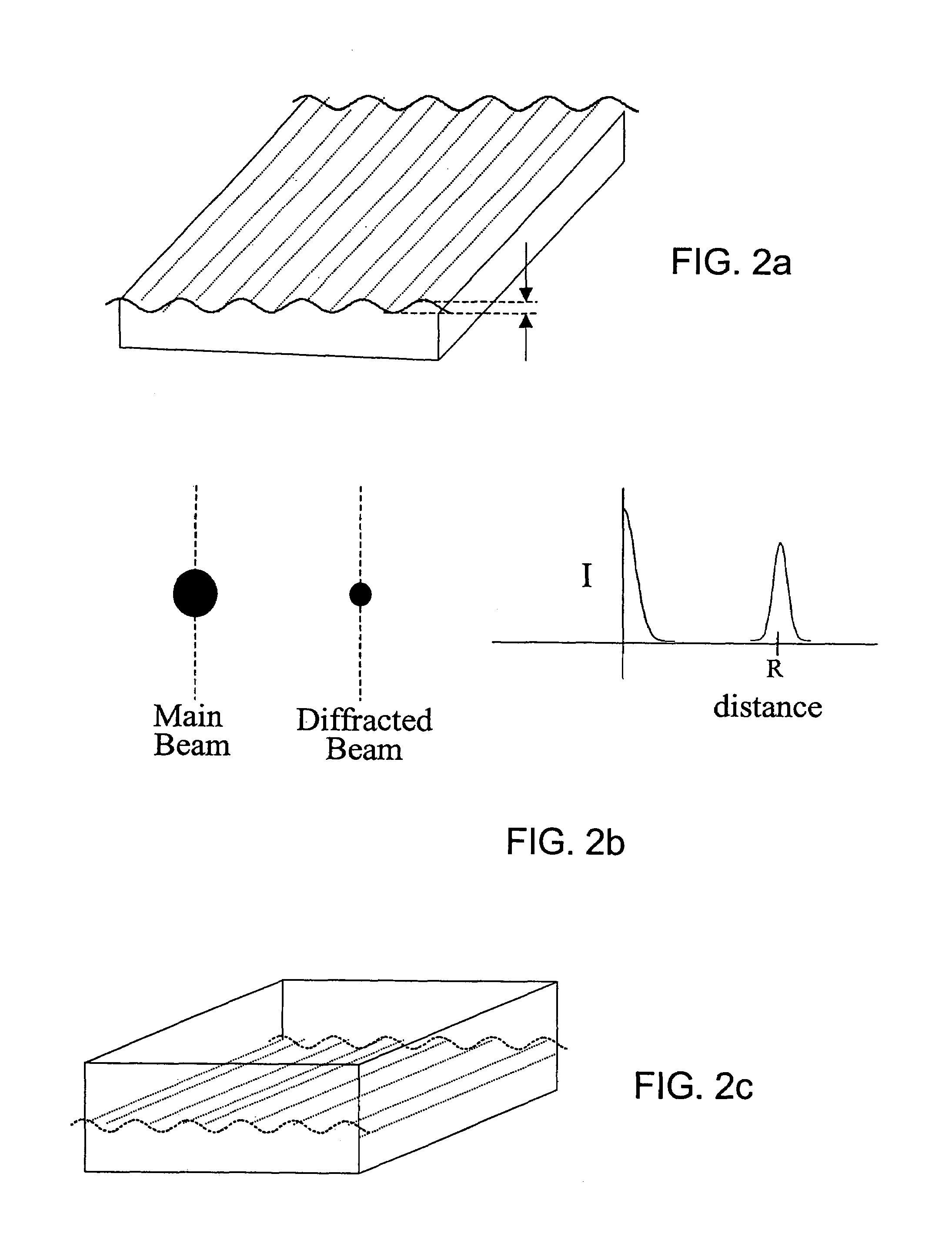Method and apparatus for assay based on light diffraction
a technology of light diffraction and assay, applied in the field of methods and apparatus for detecting analytes, can solve the problems of diffracted light incident on the substrate, not uniform scattering,
- Summary
- Abstract
- Description
- Claims
- Application Information
AI Technical Summary
Benefits of technology
Problems solved by technology
Method used
Image
Examples
example 1
Preparation of Patterned Substrate By Microcontact Printing
[0099]The substrates were patterned by microcontact printing essentialy following the procedure described in Bernard, A; Delamarche, E.; Schmid, H.; Michel, B.; Bosshard, H. R.; Biebuyck, H.; “Printing Patterns Of Proteins” Langmuir (1998), 14, 2225-2229. For evenly-spaced masters (diffraction grating), electron microscope grids or masters prepared by standard photolithography were used; otherwise various diffractive optics (Thor Labs) were employed. The poly(dimethylsiloxane) (PDMS) stamps were fabricated by using typically 10% crosslinking (Sylgard 184 Silicone elastomer kit, Dow Corning Corporation purchased from Paisley Products, Ontario Canada) and curing at 50-60° C. for 14-18 h. The PDMS stamps prepared in this manner have a diffractive surface of ˜50 mm2. The PDMS stamp was cleaned by sonication in a 2:1 solution of distilled and deionized water (ddH2O) / ethanol for 5-10 min, followed by drying under a stream of nitro...
example 2
Signal Measurement
[0101]The substrate was illuminated with either a Nd:YVO4 laser (lambda=532 nm) or a red diode laser (lambda=650 nm). The diffraction image of crossed-stamped substrates resulting from illumination by either laser can be visually observed in transmission or reflection mode prior to addition of analyte. For visual and photographic signal detection, the intensity of the diffracted light was reduced to the point when the diffraction image was no longer discernible by eye using a neutral density filter before the addition of analyte. For electronic signal detection, the intensity was reduced with a neutral density filter to a small, but measurable value to maximize the signal range of the detection device before the addition of analyte.
example 3
“Dry” Measurement
[0102]In the “dry” measurement scheme, the substrate was immersed in a solution containing the analyte for the specified period of time. The substrate was then removed from the analyte solution, washed with PBS (2 mL) and ddH2O (2 mL), and dried under a stream of N2. The substrate was illuminated with a laser and a visible diffraction image could be discerned by eye and the intensity measured using a CCD linear array or CCD area array detector hooked up to a computer. Alternatively, a photomultiplier tube mounted on an x-y translation stage was used to measure the signal intensity of a specific spot on the diffraction image by moving it across the spot while recording the intensity on an oscilloscope.
PUM
 Login to view more
Login to view more Abstract
Description
Claims
Application Information
 Login to view more
Login to view more - R&D Engineer
- R&D Manager
- IP Professional
- Industry Leading Data Capabilities
- Powerful AI technology
- Patent DNA Extraction
Browse by: Latest US Patents, China's latest patents, Technical Efficacy Thesaurus, Application Domain, Technology Topic.
© 2024 PatSnap. All rights reserved.Legal|Privacy policy|Modern Slavery Act Transparency Statement|Sitemap



